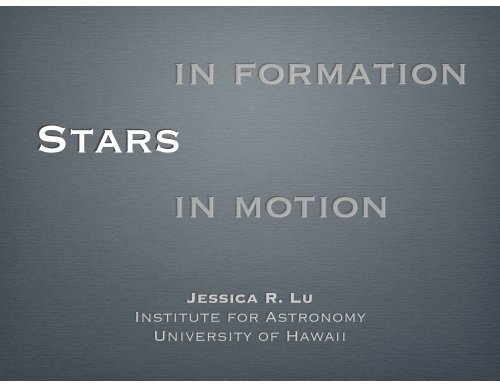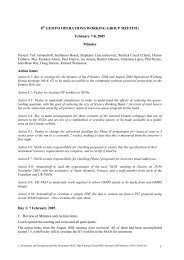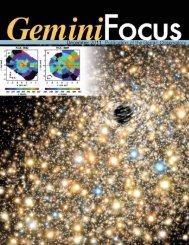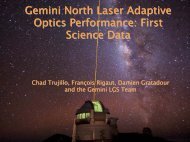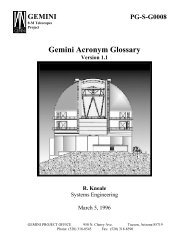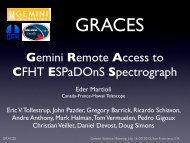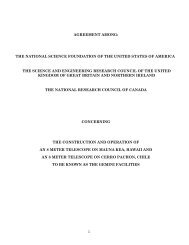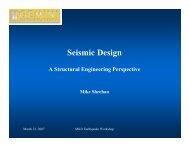Jessica R. Lu Institute for Astronomy University of Hawaii
Jessica R. Lu Institute for Astronomy University of Hawaii
Jessica R. Lu Institute for Astronomy University of Hawaii
Create successful ePaper yourself
Turn your PDF publications into a flip-book with our unique Google optimized e-Paper software.
Stars<br />
in <strong>for</strong>mation<br />
in motion<br />
<strong>Jessica</strong> R. <strong>Lu</strong><br />
<strong>Institute</strong> <strong>for</strong> <strong>Astronomy</strong><br />
<strong>University</strong> <strong>of</strong> <strong>Hawaii</strong>
Stars<br />
in <strong>for</strong>mation<br />
in motion
10 5 M sun<br />
10 4 M sun<br />
10 3 M sun
Frontiers in star <strong>for</strong>mation include massive<br />
young clusters in a range <strong>of</strong> environments.<br />
stellar initial mass function vs. environment<br />
cluster structure and dynamics<br />
as probe <strong>of</strong> star <strong>for</strong>mation process<br />
as probe <strong>of</strong> cluster evolution/fate<br />
cluster mass function vs. galaxy properties
Massive young clusters are difficult to find<br />
and observe in detail.<br />
crowded (5-100 stars/arcsec^2)<br />
deeply embedded (AV = 10-30)<br />
large on the sky<br />
membership is difficult<br />
distance is uncertain<br />
high resolution<br />
infrared<br />
> 2’ FOV<br />
astrometry<br />
spectroscopy
W51 - one <strong>of</strong> the most luminous star <strong>for</strong>ming<br />
complexes in the Galaxy.<br />
JHK Mosaic from UKIDSS Galactic Plane Survey<br />
1 degree wide
Current AO systems have too small FOV to<br />
properly characterize W51 and other GMCs.<br />
UKIDSS JHK<br />
0.8” resolution
Current AO systems have too small FOV.<br />
Gemini MCAO - ideal system <strong>for</strong> clusters at 3 - 10 kpc<br />
JWST - ideal <strong>for</strong> characterizing unresolved clusters in<br />
other galaxies<br />
need bigger FOV <strong>for</strong> nearby massive clusters<br />
(especially lower metallicity outer Galaxy clusters)<br />
still need good resolution <strong>for</strong> precise astrometry<br />
moderate resolution spectroscopy <strong>for</strong> many objects
Stars<br />
in <strong>for</strong>mation<br />
in motion
Proper motions are a powerful tool <strong>for</strong><br />
identifying cluster members.<br />
Commonly used in globular<br />
clusters.<br />
High spatial resolution<br />
optical capabilities <strong>of</strong> HST.<br />
Massive young clusters<br />
require better astrometric<br />
precision.<br />
Massive young clusters<br />
require infrared astrometry.<br />
Anderson+ 2006
Successful pilot project <strong>for</strong> W51.<br />
Done in 1 year with Keck<br />
OA (55 mas resolution).<br />
Need bigger FOV to cover<br />
whole cluster/GMC.<br />
Need spectroscopy to<br />
calibrate masses.<br />
<strong>Lu</strong> et al. in prep
Membership gives precise IMF and test bed<br />
<strong>for</strong> stellar and cluster evolution.<br />
NGC 3603<br />
Harayama+ 2008<br />
no membership info
Currently, relative astrometry is precise; but<br />
reference frames are a problem (FOV).<br />
Existing Telescopes with AO<br />
Crowded Fields: 170 µas<br />
Sparse Fields: 500 - 5000 µas<br />
Absolute Astrometry: ??<br />
MCAO ??
Astrometry is relevant to many additional<br />
science cases.<br />
Massive young star clusters<br />
Galactic Center - stellar populations, dynamics, structure<br />
Astrometric microlensing from isolated black holes<br />
Parallaxes - faint, red, crowded objects<br />
Binary/planetary companion orbits<br />
Gravitational lensing <strong>of</strong> galaxies<br />
Intermediate mass black holes<br />
Local group galaxies: orbits and internal kinematics <strong>for</strong> dark matter<br />
Jet proper motions<br />
Astrometric wobble from planets: crowded, faint, red = what Gaia won’t do.<br />
Hypervelocity stars, runaway stars from other galaxies
Slides<br />
Internal<br />
Save As:<br />
dynamics<br />
jlu_gemini_ao.key.pdf<br />
are a powerful test <strong>of</strong> star<br />
1<br />
<strong>for</strong>mation theories.<br />
2<br />
FAVORITES<br />
Graphic<br />
Macintosh HD<br />
3<br />
Desktop<br />
Fill<br />
jlu<br />
4<br />
Applications<br />
Documents<br />
5<br />
SHARED<br />
in <strong>for</strong>mation<br />
2012_06_geminiAO<br />
Stars<br />
in motion<br />
Stroke DEVICES<br />
6<br />
Remote Disc<br />
Install OS X<br />
7<br />
8<br />
Shadow Title: jlu_gemini_ao.key<br />
Angle:<br />
9<br />
Author: <strong>Jessica</strong> <strong>Lu</strong><br />
<strong>Jessica</strong> R. <strong>Lu</strong><br />
<strong>Institute</strong> <strong>for</strong> <strong>Astronomy</strong><br />
<strong>University</strong> <strong>of</strong> <strong>Hawaii</strong><br />
Subject:<br />
Offset Blur Opacity<br />
Save<br />
10<br />
64%<br />
Reflection Keywords:<br />
Processing page: 15<br />
11<br />
Security Options...<br />
Opacity<br />
Cancel<br />
New Folder<br />
12<br />
Krumholz+<br />
Cancel<br />
Save
Galactic center stellar population studies<br />
require high resolution imaging/spectroscopy.
Masses <strong>of</strong> stars, brown dwarfs, and remnants<br />
can be measured with orbits.<br />
Marois+ 2008<br />
Konopacky+ 2008
Gravitational lensing requires good astrometry<br />
(~mas) to constrain mass distributions <strong>of</strong> the lens.<br />
Marshall &<br />
Treu 2008
Astrometric microlensing can probe<br />
isolated stellar mass black holes.<br />
Sahu STScI talk 2011<br />
Ofek & <strong>Lu</strong> (in prep.)
Astrometric microlensing can probe<br />
isolated stellar mass black holes.<br />
Ofek & <strong>Lu</strong> (in prep.) Sahu Talk STScI 2011
Astrometric microlensing can probe<br />
isolated stellar mass black holes.<br />
Sahu Talk<br />
STScI 2011
Intermediate mass black holes in globular<br />
clusters.<br />
van der Marel+<br />
2009
Astrometry is relevant to many additional<br />
science cases.<br />
Galactic Center - stellar populations, dynamics, structure<br />
Astrometric microlensing from isolated black holes<br />
Parallaxes - faint, red, crowded objects<br />
Binary/planetary companion orbits<br />
Gravitational lensing <strong>of</strong> galaxies<br />
Intermediate mass black holes<br />
Local group galaxies: orbits and internal kinematics <strong>for</strong> dark matter<br />
Jet proper motions<br />
Astrometric wobble from planets: crowded, faint, red = what Gaia won’t do.<br />
Hypervelocity stars, runaway stars from other galaxies
Stars<br />
in <strong>for</strong>mation<br />
in motion<br />
<strong>Jessica</strong> R. <strong>Lu</strong><br />
<strong>Institute</strong> <strong>for</strong> <strong>Astronomy</strong><br />
<strong>University</strong> <strong>of</strong> <strong>Hawaii</strong>


